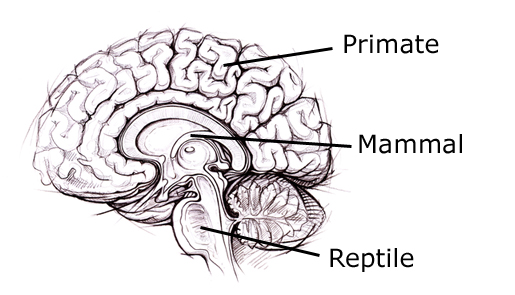I just read three brilliant blog posts by neuropsychologist Rick Hanson, in which he identifies three parts of our human brains:
- The primate brain (cortex) focuses on connecting with others.
- The mammal brain (limbic system) focuses on approaching rewards.
- The reptile brain (brain stem) focuses on avoiding harm.

Though we like to think of the primate brain as the foremost part (after all, primate means “first”), many believe it was the last part of the brain to develop. It is also the last part to receive signals from the spinal cord. So Dr. Hanson deals with the most ancient part, the brain stem, first.
The Lizard Brain
The reptile brain (brain stem) keeps our hearts beating, keeps us breathing—keeps us alive. Lizards that weren’t wary enough ended up getting eaten, which is why this part of the brain is hardwired to feel a constant, vigilant anxiety.
Dr. Hanson says this background anxiety impacts our ability to think and be happy, so he prescribes a simple technique for soothing it:
“Pet the lizard.”
- Recognize the anxiety.
- Remind yourself that you are all right.
- Take a deep breath and feel the whole breath.
- Relax your body, which will soothe the lizard.
- Maintain this state for 10, 20, 30 seconds—as long as you can.
The Mouse Brain
The mammal brain (limbic system) regulates our emotions and desires. Its main job is to move us toward the things that maintain life. Mice that weren’t constantly sniffing out food and gobbling it down didn’t survive.
Dr. Hanson says this constant hunger keeps us from noticing all the ways in which we are continuously nourished. He suggests a way to grasp this realization:
“Feed the mouse.”
- Consciously acknowledge ways in which you are being fed.
- When you eat, realize the food is becoming part of you and nourishing you.
- When you breathe, feel the air entering you to maintain your life.
- When you get paid, recognize it as nourishment.
- “Feel protected, enabled, and delighted by human craft.” (I love that wording.)
The Monkey Brain
The primate brain (cortex) handles the higher cerebral functions—thinking, making mental maps of our world, and connecting with others. Hanson identifies this last bit as the key need of the cortex. Monkeys that weren’t able to connect with other monkeys did not survive.
Dr. Hanson says the nagging worry about whether we belong hampers our thinking and happiness. He recommends the following strategy:
“Hug the monkey.”
- Think of someone who genuinely cares for you. Bring that person into your mind.
- Think of someone you genuinely care for, and bring that person in as well.
- Create a circle of caring in your mind.
- Remind yourself routinely that you are in that circle, a critical part of it.
- Feel your belonging.
Emotional Intelligence
As we’ve seen, the higher-order thinking of the cortex comes after all this lower-order thinking. Until the lizard and the mouse and the monkey in our heads feel safe and fed and part of the group, we don’t get much actual thinking done. Dr. Hanson likens the mind to a jungle. You can’t get rid of the beasts, but you can calm them down.
I’m certainly going to be using Dr. Hanson’s simple but powerful techniques to help me in the year to come. And if we can help our students apply these strategies as well, we’ll have happier, healthier learners in our classrooms.
Here are links to Dr. Hanson's posts: